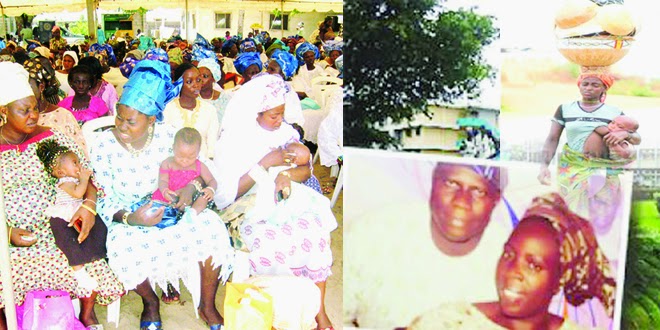MDGs 5: Nigeria faces bottlenecks in curbing 75% maternal deaths
By: Chioma Umeha
Mixed reactions greeted the news of the death of Margaret Akingbehin, a 45-year-old pregnant woman early February. She died at the Lagos University Teaching Hospital, (LUTH) Idi-Araba in Lagos due to alleged dereliction of duty by health care personnel. According to reports, Margret died after an agonising contraction and still-birth while waiting for surgery. For the Akingbehin’s family, their joy was untold over the pregnancy of Margret which came after 12 years she had her last child. Margaret in agreement with her husband, David registered for ante-natal at LUTH, where they were sure she would receive adequate care.
She had a record of regular attendance of ante-natal appointments from medical officials at LUTH. The elated couple was said to have committed N2m to refurbish their home in expectancy of the bundle of joy. Margret was due between February and March, but she was scheduled for a Caesarean Section (CS) based on age. Consequently, she quickly reported to the hospital when she noticed certain changes in her body. In fact, reports said that Margret quickly picked her purse, hospital card and drove her Sport Utility Vehicle to LUTH and later informed her husband who was not at home at the time. However, Margret was said to have died after a still birth of her baby following alleged negligence by nurses. According to reports, she was kept waiting at the pre-surgical room of the theatre from 7.00am to 4.00 pm, where she died in pains following contractions, immediately after the still birth. Margret is just one out of 1500 deaths per 100,000 live births across the country.
In Nigeria, pregnancy and childbearing is a dangerous business, especially for poorer women. Africa’s most populous nation with about 160 million or more has one of the highest maternal mortality rates. According to the WHO/United Nations Children Fund (UNICEF), in 1995, Nigeria had the third highest number of maternal deaths in the world (approximately 45000 deaths). By the year 2000, for every 100,000 live births, about 800 women died in the process of child birth. Out of the 27 million Nigerian women of reproductive age back then about two million did not survive either pregnancy or childbirth. In 2008, according to UN report, the figure stood at between 1000 and 1500 deaths per 100,000 live births. The State of the World Children Report 2009 stated that one out of nine global maternal deaths occurred in Nigeria. At the moment, the country ranks second on maternal mortality rate in the world with about 144 girls and women dying daily from complication of pregnancy and child birth.
One in every 18 women die giving birth compared to one in 4800 in the US. According to the survey conducted in February 2010, the record stands at between 165 per 100,000 live births in the South West and 1549 per 100,000 live births in the North East. World Health Organization (WHO) 2006 defines maternal death as the death of women while pregnant or within 42 days of termination of pregnancy irrespective of the duration and site of the pregnancy from any cause related to, or aggravated by the pregnancy or its management but not from accidental or incidental causes. Maternal mortality is a multi–dimensional problem which does not only affect the family involved but has a great effect on the society as a whole. The death of a woman during pregnancy, labour or pueperium is a tragedy that carries a huge burden of grief and pain, and has been described as a major public health problem in developing countries. When a mother dies, the children’s chances of reaching adult life is slim. This is majorly due to lack of everyday care and security.
The young children may have to take care of themselves and this may in turn affect their school attendance. Lack of proper education may in turn weaken the child’s chances of reaching better life standards. Monitoring maternal mortality is difficult due to poor reporting and lack of proper methods to measure actual death rates. Estimating the real figure is difficult as only 31 per cent women deliver in health facilities. The gap of maternal deaths between rich and poor countries is wide with 99 per cent of these deaths occurring in the developing world. Out of the 49 countries which record highest maternal deaths, 34 of these countries are in Sub – Saharan Africa, where one woman in 16 dies from pregnancy or childbirth compared to one in 2800 in the developing world. Some bleed to death at home because, amongst other reasons, they could not afford the transport to the facility. UNICEF observes that maternal mortality have many triggers, both direct and indirect.
Poorly funded and culturally inappropriate health and nutrition services, food insecurity, inaccurate feeding practices and lack of hygiene are direct causes of mortality in both children and mothers. The indirect causes may be less obvious externally, but play just as large a role in mortality statistics. Female illiteracy adversely affects maternal and child survival rates and is also linked to early pregnancy. In many countries, especially where child marriage is prevalent, the lack of primary education and lack of access to healthcare contribute significantly to child and maternal mortality statistics. UNICEF also notes that discrimination and exclusion of access to health and nutrition services due to poverty, geographic and political marginalization are factors in mortality rates as well. The major reported causes of maternal deaths in developing world are: severe maternal bleeding; infections; obstructed or prolonged labour; unsafe abortion; hypertensive disorders of pregnancy especially eclampsia.
Others are hemorrhage, sepsis, toxemia and complications from abortion account for 62 per cent of maternal deaths in Nigeria. According to research, the North West has the highest maternal mortality rate, seconded by North-East. Death from post partum hemorrhage (PPH) ranges between 23 per cent and 44 per cent of total maternal deaths especially in the Northern States. The ratio of women dying from PPH is 1 in 6 in the North East and North West as against one in 18 between South West and South East geopolitical zones. A break-down of the statistics is: eclampsia – 27 per cent, PPH – 25 per cent, infection – 15 per cent, unsafe abortion – 13 per cent and other causes – 20 per cent. Other health issues which affect women chances of healthy livelihood in the pre-natal and post partum period are high blood pressure, cancer, heart conditions and other non-communicable diseases. HIV/AIDS is an additional new concern for maternal/child health survival. Another statistics showed the break-down as follows: bleeding – 17 per cent, hypertension – 19 per cent, anaemia – 12 per cent, unsafe abortion – 11 per cent, infections – 10 per cent; obstructed labour – seven per cent and other causes – 24 per cent. Studies has also underlying factor of most maternal deaths is ignorance and apathy by women and the society in general. Commenting, a Head of Department (HOD) at LUTH who preferred to remain anonymous said that the attitude of doctors and nurses contribute to the increase of maternal deaths and morbidity in the country. According to HOD, recent developments give credence to her claims.
Making reference to Margret’s death, she insisted that the doctors and nurses were careless. The HOD further lamented the poor state of primary health care in the country and reckless attitude of health care personnel who are only concerned about enriching their pockets rather than care for patients. According to her, many of the doctors are more interested in running their private hospitals than provide the services which they were employed to do. She noted that over 90 per cent of the doctors in public institutions own private hospitals which occupy them and makes it difficult for them to effectively carry out their duties. Condemning the trend, she said, “Though their private hospitals lack basic facilities, like oxygen, yet these doctors keep redirecting patients from a public institution like LUTH to their clinic.” She further reasoned that this is one of the factors that led to Margret’s death. According to her, doctors were not on ground to attend to Margret. While grieving over Margret’s death, she said that the deceased represent hundreds of women who die across the country due to pregnancy-related issues. Dr. Ejike Oji, former Ipas Boss in Nigeria, also described maternal health as a public health crisis.
He said; maternal health is “The Paradox of our times,’ adding – ‘a sine qua non to development.” The Ipas Chief observed that most women ignore early warning signs due to lack of adequate knowledge and information about danger signals during pregnancy and labour and so delay to seek care. Also, adequate preparation for any emergency before, during and after delivery is also lacking. He listed other factors which contribute to high incidence of maternal death to include: educational attainment, socio-economic status and antenatal attendance, poor socio-economic development, weak health care system and socio – cultural barriers to care utilization. According to him, one of the socio-cultural variables in the prediction of maternal mortality is early marriage which accounts for about 23 per cent of maternal mortality due to severe hemorrhage resulting from obstructed and prolonged labour. The narrow pelvis of these women may also result to fistula and often time still births. Similarly, the Ipas Director said that poor family planning practice contributes to maternal deaths.
According to him, unsafe abortions accounts for at least 13 per cent of all maternal deaths. He reasoned that there will be a lot of unwanted pregnancies among the young age group who are not aware of good contraceptive methods. They often resort to unsafe abortion with its resultant infections, haemorrhage and injuries to the cervix and uterus. Oji said that family planning will lead to a 30 per cent reduction in maternal deaths, but regretted the country’s heavy dependence on donors. He said; “donors have been driving our FP services. It should be in the national budget.” “Female genital mutilation (FGM) is a major indirect cause of maternal mortality in Nigeria. It is a risk factor for obstructed labour. Pains, infections and haemorrhage result from FGM, as well as the risk of tetanus and even HIV infections. Problem following FGM is that scar tissue stretches poorly in child birth leading to perineal tear and haemorrhage which also accounts for maternal deaths due to inadequate emergency obstetric care,” Oji said. He further noted that inadequate obstetric and post partum care contributes to maternal death. His words; “about 69 per cent of women still give birth in a traditional setting either at home or in a Church. Only 30 per cent of people in the rural areas have access to health care within 4 km distance.
The same issue is applicable to people in the urban setting.” This is even as lamented that most attendants of these births in the churches are unskilled. He also bemoaned the role of illiteracy and poverty in increasing the incidence of maternal death. “The lack of primary education and lack of access to health care contribute significantly to child and maternal mortality statistics,” he said. He reasoned that women who complete secondary education are more likely to delay pregnancy, receive prenatal and post natal care and have their birth attended to by qualified medical personnel. Oji called for creation of emergency transportation services, upgrade of transportation system and enhancement of referral systems to enable women to reach health care centres and receive appropriate care on time. Oji’s view corroborates with Dr. Mahmoud Fathalla, Former President of Federation of International Gynaecologists and Obstetricians (FIGO). Bemoaning the increasing incidence of maternal deaths, Both Oji and Fathalla agree that girl child education is essential in reducing maternal deaths.
According to them, the South East (SE) is a good evidence for this strategy. Experts have called for massive investment in the country’s educational system. “The first health care system is in the house hold. The more educated the house hold the better equipped they are to provide care either by self or purchase,” Fathalla said. Observing that women don’t receive prompt care at health facilities, Fathalla advocated for provision of 24 -hour obstetric care; upgrade of quality of care at health facilities; establishment of national protocols to treat obstetric complications; ensuring adequate stocks of medical supplies and blood. According to the obstetrician, enhancing referral systems between communities and health facilities will help to reduce maternal deaths. He insisted that a woman must be able to exercise control over her sexual and reproductive health if she is to achieve her fullest potential as a human being. He urged government, health care providers, development partners, legal practitioners, especially the International Federation of African Lawyers (FIDA) among many others to increase their commitment in empowering women to enable them exercise their reproductive rights. Experts believe that the growing incidence of maternal deaths is an unhealthy trend which has become a matter of great concern and are calling for concerted approach from stakeholders to curtail it.
For instance, Fathalla, lamented; “Women are not dying because of diseases we cannot treat. They are dying because societies have yet to make the decision that their lives are worth saving.” This is in line with the observation of Former United Nations Secretary-General Kofi Annan towards addressing poor health care in the continent including, high maternal deaths. Annan said: “It is my aspiration that health finally will be seen not as a blessing to be wished for, but as a human right to be fought for.” The Millennium Development Goals (MDGs) focuses attention, resources, and action on improving the well-being of all peoples. Two of the goals (MDGs 4 and 5) were to reduce the childhood mortality rate and maternal mortality ratio, by two-thirds and three quarters (75 per cent), respectively between 1990 and 2015. It is expected that decline in maternal mortality must accelerate substantially in the period to 2015, if any country is to reach these goals. The maternal mortality rate of any country is very significant and has implications for the attainment of the MDGs.
However, there are indications that Nigeria is lagging behind in achieving universal coverage of key maternal and child health intervention and will unlikely meet the target of the MDGs. According to UNICEF Executive Director, Ann Veneman, “midway to 2015 deadline for MDGs, Nigeria continues to record unacceptably high maternal, newborn and child mortality”. Nigeria ranks as one of the 13 countries in the world with the highest maternal mortality rate and is still not listed among the 10 countries seen to have made rapid progress to meet the goals. The circumstance surrounding the death of women like Margaret has thrown a poser which must be answered: How prepared is Nigeria to meet MDGs Target 4 and 5?
This story was published in Newswatch Times on September 26, 2013.




Comments
Post a Comment